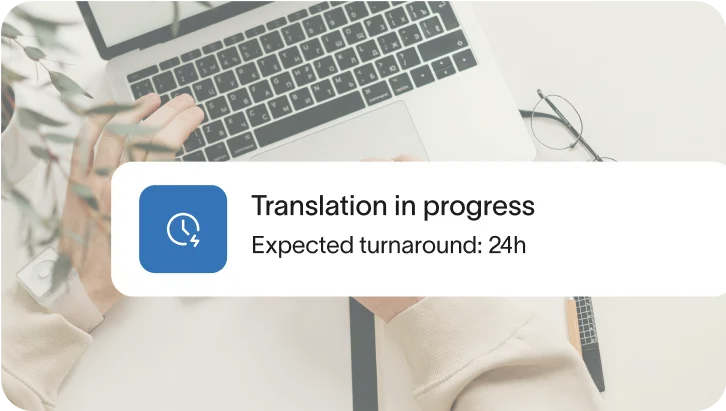USCIS translation services
Immigration paperwork can be overwhelming. We support you in this critical step with certified USCIS translations backed by an acceptance guarantee, unlimited revisions, and 24-hour delivery for $24.95 per page.
Immigration paperwork can be overwhelming. We support you in this critical step with certified USCIS translations backed by an acceptance guarantee, unlimited revisions, and 24-hour delivery for $24.95 per page.

Trusted by professionals from top companies worldwide
When applying for U.S. immigration benefits, USCIS requires that any foreign-language documents be submitted with a certified English translation. This includes birth and marriage certificates, passports, diplomas, and other vital records for green cards, visas, citizenship, asylum applications, refugee applications, and deportation defense.
RushTranslate ensures your translations meet every USCIS requirement. Each document is translated word-for-word, reviewed for completeness, and delivered with a signed certification statement. All translations come with unlimited revisions and are backed by our 100% acceptance guarantee.
Trusted by more than 230K customers and backed by 4.8 stars from 23K reviews, RushTranslate provides fast, affordable, and reliable USCIS certified translations that help keep your immigration case on track without unnecessary delays.
Every translation is word-for-word and certified to comply fully with USCIS submission standards.
Certified USCIS translations delivered in 24 hours with unlimited revisions for $24.95 per page.
Move forward with confidence with our 100% money-back acceptance guarantee.

We regularly translate and certify a wide range of USCIS documents for individuals, businesses, and organizations. Our skilled translation team has extensive experience handling these documents with precision and accuracy. Some of the most commonly translated types include:
At RushTranslate, we ensure that all certified translations meet USCIS's translation guidelines and we guarantee acceptance. Below are their specific requirements, which must be followed to ensure your documents are accepted without issues or delays:
Our translators are native speakers who ensure that your documents are translated clearly and accurately into English, meeting the requirements for USCIS submission.
We understand the importance of timeliness, which is why we offer quick turnaround times without sacrificing accuracy or attention to detail.
Our translations are certified and meet the high standards required by USCIS, helping to minimize the chances of delays in your submission process.
Your documents are handled with the utmost privacy and security, ensuring that all files are translated and delivered confidentially.
We deliver high-quality certified translations that meet USCIS's requirements. If your translation isn't accepted, we'll refund your money and continue working until it is.
Our streamlined process makes it easy to get your documents translated quickly and efficiently.
Select your language pair, upload your documents, and add any optional services to quickly get your translation process started.



A professional translator will carefully translate your document. You'll have the opportunity to review it and request edits before it is finalized.



You'll receive the final translated documents, along with a signed and stamped certification on our company letterhead if certification is selected.



We take pride in delivering consistent, high-quality service. With 4.8 stars from 23,090 reviews on Google, BBB, and our site, you can rely on us for your translation needs.
Get answers to common questions about translating and certifying USCIS documents. Learn why certified translations are required, which documents need translation, who can provide them, turnaround times, revision policies, and our acceptance guarantee.
A certified translation includes a signed statement from the translator or translation agency attesting to the accuracy and completeness of the translation. USCIS requires certified translations for any documents not originally in English to ensure that your documents are properly translated.
Any document not in English that is required for USCIS submission must be translated. Common documents include: birth certificates, change of names, marriage certificates, medical records, and passports.
Typically you can't certify your own translations, but some recipients will accept a certified translation from a friend or family member fluent in the language pair. However, most organizations require a certified translation from a professional translator or agency like RushTranslate so they can check the validity of the translation.
Most 1-3 page documents (up to 750 words) are delivered digitally within 24 hours. For a precise estimate, request a quote. Our translations are completed by professional human translators, and turnaround times vary based on factors such as word count, language pair, translator availability, and document complexity. Expedited turnaround is available, reducing the standard time by approximately 50%. Learn more about translation turnaround times.
We strive to always deliver high-quality translations, but if you need any revisions, we'll make them promptly at no extra cost. Accuracy and your satisfaction are our top priorities, and free revisions are included with all RushTranslate services.
Our translations are generally accepted by governments, courts, universities, and other institutions worldwide. However, it is your responsibility to confirm that our translation meets the specific requirements of the receiving office. If you're unsure, contact us with their requirements, and we'll review them with you. For certain common recipients where requirements are well-defined, we offer an acceptance guarantee.